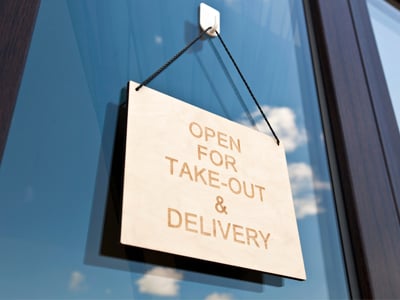Portable. Affordable. Familiar.
Those may be the three magic words that describe what diners are looking for right now, according to a recent National Public Radio story on restaurants that are doing well in the downturn. Burritos, pizza, wings — comforting food that adapts well to a takeout or delivery model.
But food isn’t the only factor. Technology, marketing, trends and operations all can help restaurants defy the odds and have a profitable year. Here are a few strategies that can be effective.
Adapting popular promotions to an off-premises model.
Dickey’s Barbecue Pit, a Dallas-based chain with over 500 locations, had big plans for 2020. The company’ signature promotion, called “Upgrade Your ‘Cue,’” would have added four new self-serve sauces to in-store caddies and six new sandwiches. Then, everything went haywire.
“We were challenged to adjust this national dine-in, self-serve sauce promotion with national media to be appropriate for an off-site dining, delivery-only reality with no ability to self-serve, explained CEO Laura Rea Dickey. “We had three weeks to make these changes.” The team did it, offering the new sauces and sandwiches for online ordering. The new items proved to be a hit, especially the Carolina Pulled Pork and Brisket Double Cheese, and Dickey’s has seen its check count rise year over year.
Giving customers more avenues for physical access.
Many chains are reimagining their physical footprint for the future. The Wall Street Journal illustrates what the QSR of the future might look like: covered parking spaces for mobile order pickup, multiple drive-through lanes, and walk-up windows.
Walk-up takeout windows are seeing brisk business at restaurants in urban environments. An excellent example is All Day Baby in Los Angeles, which had been open only two months when the pandemic hit. The restaurant began selling its beloved biscuits out of a walk-up window. After selling out, they experimented with different concepts: a tiki window (pupu platters and cocktails) and a BBQ window. “When space allows, it’s a lower-lift way to test out adapted menus and new concepts, and enhance what a restaurant offers to a community right now,” OpenTable says.
Trimming the menu.
Restaurants as diverse as Denny’s and Ruth’s Chris have been rewriting their menus to cut out less-ordered and more labor-intensive dishes. Considering a similar move? Don’t be afraid that customers will complain. “Operators say they’ve been surprised by how readily the cutbacks have streamlined operations, shaved food and labor costs and quickened throughput—typically without dampening sales,” Restaurant Business Online reports.
Investing in the online ordering/delivery experience.
Wingstop is an inspiring success story in the fast-casual segment, showing a 32% same-store sales increase in Q2 2020 when almost every other brand was in a slump. Some of that success can be attributed to the popularity of its core offering — wings are portable, affordable, and familiar, and they can’t be made easily at home. But analysts also credit Wingstop’s thoughtful approach to delivery, including the exclusive partnership it launched with DoorDash in 2018.
As part of that partnership, Forbes reports, Wingstop ensured the guest experience was as seamless for DoorDashers as for diners, testing its in-store layout to make sure they could easily pick up food orders and fountain drinks. When the pandemic began, Wingstop and DoorDash offered free delivery — which not only delighted customers, but allowed Wingstop to collect their information and market directly to them.
Focusing on healthier offerings.
Another pandemic winner is Tropical Smoothie Café, which reported a 19.5% increase in comp sales in Q3 2020. Tropical Smoothie’s CEO, Charles Watson, points to consumers wanting lighter takeout options, such as bowls, wraps and smoothies. “At the end of the day, the American consumer wants a convenient and healthier option,” Watson tells Nation’s Restaurant News, emphasizing the -er: “If we served wheatgrass on cardboard, we wouldn’t have 900 locations.”
Portability is key. Smoothies last around 45 minutes from the time that they’re made, Watson says, which is plenty of time for delivery. The smoothie market overall is strong: industry research predicts 7% compound annual growth rate by 2024. Could smoothies be a check-booster for your takeout/delivery business? It’s easy to experiment: All you need is a high-performance commercial blender to swiftly satisfy guests’ desire for healthful drinks to go.
Hamilton Beach Commercial is here to help our partners succeed. Check out the latest food news on our blog, where we’re celebrating Foodservice Heroes and sharing strategies for building your business.


